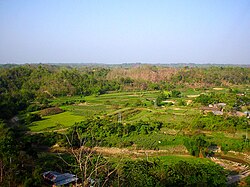Chittagong Hill Tracts
The Chittagong Hill Tracts (CHT) are an autonomously administered province with an area of 13,295 km² in the extreme southeast of Bangladesh .
geography
The Chittagong Hill Tracts are located in southeast Bangladesh within the three districts of Khagrachhari , Rangamati and Bandarban in the east of the Chittagong division . They border the states of Tripura and Mizoram in India and the administrative units of Chin State and Rakhine State in Myanmar .
In contrast to the rest of Bangladesh, the region is hilly and covered by a dense jungle. It contains the highest mountains in Bangladesh, Mowdok Mual ( 1045 m ), Zow Tlang ( 999 m ), Dumlong ( 997 m ) and Keokradong ( 980 m ).
history
The Chittagong Hill Tracts were under the rule of Tripura , Arakans and the Sultans before they fell under the control of the British East India Company in 1760 . This power was initially limited to the collection of taxes. The Chittagong Hill Tracts administrative district was then created in 1860 during British colonial rule by the Frontier Tribes Act 22 of 1860 . In 1900 the Chittagong Hill Tract Regulation Act divided the mountain area into three sub-administrative divisions.
The British colonial administration protected the Jumma from the influx of Muslim Bengali in order to preserve the social structure and culture. After the founding of Pakistan in the course of the partition of India, the Jumma residents of Bangladesh, which was then part of Pakistan, were classified by the Pakistani government as anti-Pakistani and the influx of non-locals was allowed and encouraged. Furthermore, the huge dam for the Karnaphulistausee was built in the 1960s, which flooded the best arable land (40%) and the settlement area of 100,000 Jumma and thus destroyed it.
After Bangladesh was constituted as a state in the course of independence from Pakistan after a war of civil secession, the Jumma made demands on the new government that the autonomy of the CHT, the preservation of the state of the settlement of 1900, the recognition of the three Jumma kings as heads of the Chittagong Hill Tract and the ending of the previously targeted forced immigration of non-Jumma. All of these demands were rejected by Prime Minister Mujibur Rahman . Since then, the Jumma have been the victims of politically motivated persecution and collective repression, as well as rape and torture of Jumma by the security forces. The army of Bangladesh is omnipresent in the CHT. In response to this, militant resistance groups formed among the Jumma and retreated into the jungle.
In 1997 the Jana Samhati Samiti (JSS), the collective political agency of the Jumma, signed an agreement with the government of Bangladesh.
A problem that continues to this day is the strong population pressure in the extremely densely populated lowlands of Bangladesh. On July 16, 2016, the Bangladeshi Information Minister Hasanul Haq Inu stated that the Chittagong Hill Tracts with 1.6 million inhabitants are "filled to the brim with population" and that further influx of people from the lowlands can no longer be allowed. There is an acute shortage of arable land.
population
The mountainous region is mainly populated by 13 people groups who see themselves as the Jumma , the first people to colonize the Chittagong Hill Tracts. They are called Chakma , Marma , Tripuri , Tanchangya , Mru , Murung , Lushai , Khumi , Chak , Khyang , Bawm , Pankhua and Reang . The Jumma differ from the rest of the population in Bangladesh in terms of their language, culture, religion and ethnicity. While the Bengal are assigned to the Indo-European peoples, the Jumma are of Mongolian origin.
Web links
- Article on the political situation of the Chittagong Hill Tracts by Anja Fischer at suedasien.info
- Survival International human rights organization for the protection of indigenous peoples
- JP Mills and the Chittagong Hill Tracts, 1926/27 (Tour Diary, Reports, Photographs)
Individual evidence
- ↑ Nure Alam Durjoy: Inu: No more space for settlers in CHT. (No longer available online.) Dhaka Tribune , July 16, 2016, archived from the original on July 16, 2016 ; accessed on July 16, 2016 . Info: The archive link was inserted automatically and has not yet been checked. Please check the original and archive link according to the instructions and then remove this notice.

